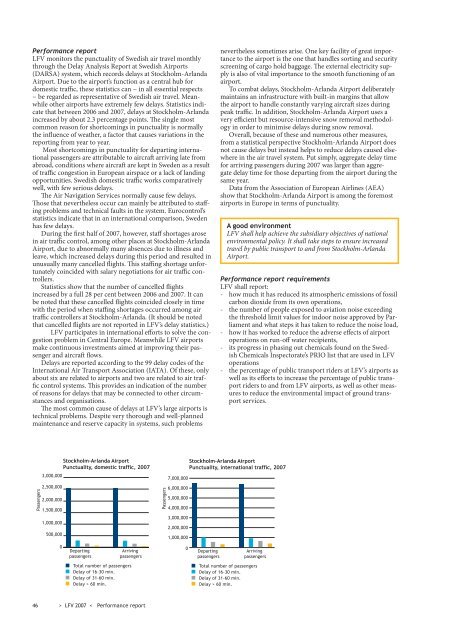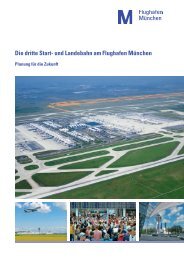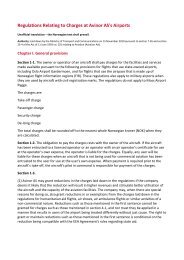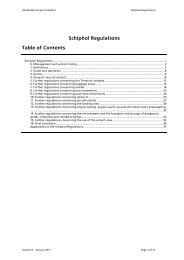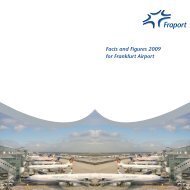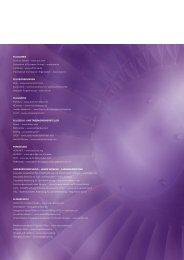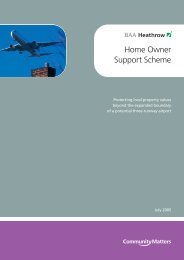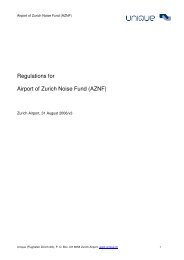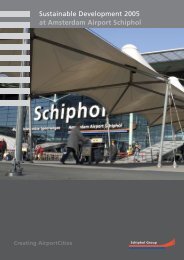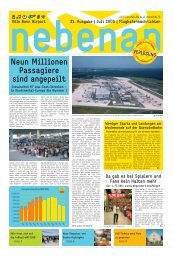The LFV Group - Airport Mediation - Home
The LFV Group - Airport Mediation - Home
The LFV Group - Airport Mediation - Home
- No tags were found...
Create successful ePaper yourself
Turn your PDF publications into a flip-book with our unique Google optimized e-Paper software.
Performance report<strong>LFV</strong> monitors the punctuality of Swedish air travel monthlythrough the Delay Analysis Report at Swedish <strong>Airport</strong>s(DARSA) system, which records delays at Stockholm-Arlanda<strong>Airport</strong>. Due to the airport’s function as a central hub fordomestic traffic, these statistics can − in all essential respects− be regarded as representative of Swedish air travel. Meanwhileother airports have extremely few delays. Statistics indicatethat between 2006 and 2007, delays at Stockholm-Arlandaincreased by about 2.3 percentage points. <strong>The</strong> single mostcommon reason for shortcomings in punctuality is normallythe influence of weather, a factor that causes variations in thereporting from year to year.Most shortcomings in punctuality for departing internationalpassengers are attributable to aircraft arriving late fromabroad, conditions where aircraft are kept in Sweden as a resultof traffic congestion in European airspace or a lack of landingopportunities. Swedish domestic traffic works comparativelywell, with few serious delays.<strong>The</strong> Air Navigation Services normally cause few delays.Those that nevertheless occur can mainly be attributed to staffingproblems and technical faults in the system. Eurocontrol’sstatistics indicate that in an international comparison, Swedenhas few delays.During the first half of 2007, however, staff shortages arosein air traffic control, among other places at Stockholm-Arlanda<strong>Airport</strong>, due to abnormally many absences due to illness andleave, which increased delays during this period and resulted inunusually many cancelled flights. This staffing shortage unfortunatelycoincided with salary negotiations for air traffic controllers.Statistics show that the number of cancelled flightsincreased by a full 28 per cent between 2006 and 2007. It canbe noted that these cancelled flights coincided closely in timewith the period when staffing shortages occurred among airtraffic controllers at Stockholm-Arlanda. (It should be notedthat cancelled flights are not reported in <strong>LFV</strong>’s delay statistics.)<strong>LFV</strong> participates in international efforts to solve the congestionproblem in Central Europe. Meanwhile <strong>LFV</strong> airportsmake continuous investments aimed at improving their passengerand aircraft flows.Delays are reported according to the 99 delay codes of theInternational Air Transport Association (IATA). Of these, onlyabout six are related to airports and two are related to air trafficcontrol systems. This provides an indication of the numberof reasons for delays that may be connected to other circumstancesand organisations.<strong>The</strong> most common cause of delays at <strong>LFV</strong>’s large airports istechnical problems. Despite very thorough and well-plannedmaintenance and reserve capacity in systems, such problemsnevertheless sometimes arise. One key facility of great importanceto the airport is the one that handles sorting and securityscreening of cargo hold baggage. <strong>The</strong> external electricity supplyis also of vital importance to the smooth functioning of anairport.To combat delays, Stockholm-Arlanda <strong>Airport</strong> deliberatelymaintains an infrastructure with built-in margins that allowthe airport to handle constantly varying aircraft sizes duringpeak traffic. In addition, Stockholm-Arlanda <strong>Airport</strong> uses avery efficient but resource-intensive snow removal methodologyin order to minimise delays during snow removal.Overall, because of these and numerous other measures,from a statistical perspective Stockholm-Arlanda <strong>Airport</strong> doesnot cause delays but instead helps to reduce delays caused elsewherein the air travel system. Put simply, aggregate delay timefor arriving passengers during 2007 was larger than aggregatedelay time for those departing from the airport during thesame year.Data from the Association of European Airlines (AEA)show that Stockholm-Arlanda <strong>Airport</strong> is among the foremostairports in Europe in terms of punctuality.A good environment<strong>LFV</strong> shall help achieve the subsidiary objectives of nationalenvironmental policy. It shall take steps to ensure increasedtravel by public transport to and from Stockholm-Arlanda<strong>Airport</strong>.Performance report requirements<strong>LFV</strong> shall report:- how much it has reduced its atmospheric emissions of fossilcarbon dioxide from its own operations,- the number of people exposed to aviation noise exceedingthe threshold limit values for indoor noise approved by Parliamentand what steps it has taken to reduce the noise load,- how it has worked to reduce the adverse effects of airportoperations on run-off water recipients,- its progress in phasing out chemicals found on the SwedishChemicals Inspectorate’s PRIO list that are used in <strong>LFV</strong>operations- the percentage of public transport riders at <strong>LFV</strong>’s airports aswell as its efforts to increase the percentage of public transportriders to and from <strong>LFV</strong> airports, as well as other measuresto reduce the environmental impact of ground transportservices.Passengers3,000,0002,500,0002,000,0001,500,0001,000,000500,000Stockholm-Arlanda <strong>Airport</strong>Punctuality, domestic traffic, 2007Passengers7,000,0006,000,0005,000,0004,000,0003,000,0002,000,0001,000,000Stockholm-Arlanda <strong>Airport</strong>Punctuality, international traffic, 20070DepartingpassengersArrivingpassengers0DepartingpassengersArrivingpassengersTotal number of passengersDelay of 16-30 min.Delay of 31-60 min.Delay > 60 min.Total number of passengersDelay of 16-30 min.Delay of 31-60 min.Delay > 60 min.46 > <strong>LFV</strong> 2007 < Performance report


